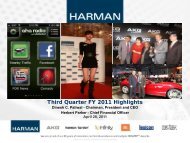Create successful ePaper yourself
Turn your PDF publications into a flip-book with our unique Google optimized e-Paper software.
<strong>Harman</strong> International Industries, Incorporated and Subsidiaries<br />
(Dollars in thousands, except per-share data and unless otherwise indicated)<br />
Accumulated Other Comprehensive Income (“AOCI”): At June 30, 2009 and 2008 AOCI consisted of<br />
the following:<br />
June 30,<br />
Income/(Loss): 2009 2008<br />
Cumulative translation adjustment .................................. $84,555 $204,806<br />
Pension benefits ................................................. (13,821) (11,947)<br />
Unrealized loss on hedging derivatives ............................... (9,041) (1,328)<br />
Unrealized loss on available-for-sale securities ......................... (4,495) —<br />
Total accumulated other comprehensive income ........................ $57,198 $191,531<br />
Treasury Stock: We account for repurchased common stock under the cost method and include such<br />
treasury stock as a component of our Common shareholders’ equity. Retirement of Treasury stock is recorded as<br />
a reduction of Common stock and Additional paid-in-capital at the time such retirement is approved by our<br />
Board of Directors.<br />
Recently Adopted Accounting Pronouncements:<br />
Subsequent Events: In May 2009, the FASB issued SFAS No. 165, “Subsequent Events” (“SFAS 165”),<br />
which establishes general standards of accounting and disclosure for events that occur after the balance sheet date<br />
but before financial statements are issued. SFAS 165 is effective for all interim and annual periods ending after<br />
June 15, 2009. We adopted SFAS 165 upon its issuance and it had no material impact on our consolidated<br />
financial statements. See “Subsequent Events” above for this new disclosure.<br />
Derivative Instruments and Hedging Activities: On January 1, 2009 we adopted SFAS No. 161,<br />
“Disclosures about Derivative Instruments and Hedging Activities, an amendment of FASB Statement No. 133”<br />
(“SFAS 161”). SFAS 161 requires additional disclosures regarding a company’s derivative instruments and<br />
hedging activities by requiring disclosure of the fair values of derivative instruments and their gains and losses in<br />
a tabular format. It also requires disclosure of derivative features that are credit risk-related, as well as crossreferencing<br />
within the notes to the financial statements to enable financial statement users to locate important<br />
information about derivative instruments, financial performance and cash flows. The only impact from this<br />
standard was to require us to expand our disclosures regarding our derivative instruments. Refer to Note 7 –<br />
Derivatives for additional information.<br />
Fair Value Accounting: On July 1, 2008, we adopted SFAS No. 157, “Fair Value Measurements” (“SFAS<br />
157”). SFAS 157 defines fair value, establishes a market-based framework or hierarchy for measuring fair value<br />
and expands disclosures about fair value measurements. SFAS 157 is applicable whenever another accounting<br />
pronouncement requires or permits assets and liabilities to be measured at fair value. SFAS 157 does not expand<br />
or require any new fair value measures; however, the application of this statement may change current practice.<br />
In February 2008, the FASB issued FASB Staff Position (“FSP”) No. FAS 157-1, “Application of FASB<br />
Statement No. 157 to FASB Statement No. 13 and Other Accounting Pronouncements That Address Fair Value<br />
Measurements for Purposes of Lease Classification or Measurement under Statement 13”, (“FSP FAS 157-1”)<br />
and FASB Staff Position No. 157-2, “Effective Date of FASB Statement No. 157” (“FSP FAS 157-2”).<br />
Collectively, FSP FAS 157-1 and FSP FAS 157-2 defer the effective date of SFAS 157 to fiscal years beginning<br />
after November 15, 2008 for nonfinancial assets and liabilities, and amend the scope of SFAS 157. Accordingly,<br />
our adoption of SFAS 157 in fiscal year 2009 was limited to financial assets and liabilities, which primarily<br />
affects the valuation of our derivative contracts. The adoption of SFAS 157 did not have a material effect on our<br />
financial condition or results of operations. We do not believe the full adoption of SFAS 157 with respect to our<br />
57





